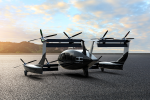
Hydrogen-powered VTOL Vertiia to use innovative heat exchangers by Conflux
3dprintingindustry.com
Conflux Technology has partnered with Australian aircraft manufacturer AMSL Aero to develop a thermal management system for Vertiia, a hydrogen-powered electric vertical take-off and landing (VTOL) aircraft.Designed for zero-emissions long-range flight across distances of up to 1,000 km, Vertiia relies on efficient heat regulation to support its hydrogen fuel cell powertrain. Conflux brings its expertise in additively manufactured heat exchangers to the project, aiming to meet the thermal and structural demands of next-generation flight.Hydrogen fuel cells represent a transformative technology in Australias pursuit of sustainable energy solutions. We are proud to incorporate our heat exchange technology to enhance the efficiency and performance of Vertiias hydrogen fuel cells. Together, were advancing innovation in creating world-leading sustainable air transport, says Michael Fuller, CEO & Founder of Conflux Technology.AMSL Aeros Vertiia aims to be the worlds most efficient long-range, zero emissions, electrical VTOL aircraft. Photo via Conflux Technology.Tailored cooling solutions for hydrogen-powered flightAccording to Conflux, initial efforts focused on producing three concept heat exchangers capable of handling continuous thermal loads while reducing both weight and aerodynamic drag.Each concept was developed with compact packaging in mind, accommodating the space limitations of aircraft design without compromising performance. Work has now progressed to a second phase, which involves building and testing a complete proof-of-concept assembly within Vertiias propulsion system.During take-off, landing, and hover operations, hydrogen VTOL aircraft face sharp increases in heat output. To manage those transient thermal spikes, the cooling system must deliver consistent performance while remaining lightweight and compact.According to the company, 3D printing enables highly tailored geometries that can conform to tight spaces, an approach well-suited to hydrogen aviation. As a result, Conflux is using its patented thin-walled structures that support both thermal efficiency and low drag across variable flight conditions.AMSL Aero is committed to Victoria for future development of Vertiia and Conflux is one of Victorias industrial champions, making the Avalon Air Show the ideal place for us to unveil this partnership, said AMSL Aero chairman Chris Smallhorn.The partnership builds on Confluxs previous work in aerospace, where the company has been applying AM to a range of thermal management applications.Simon Coburn, Hydrogen Systems Engineer at AMSL Aero, highlighted the significance of Confluxs manufacturing certification under AS9100D and its rapid delivery capabilities, stating that both factors are important for enabling Vertiias advancement as a long-range hydrogen-powered VTOL.Close-up of Conflux heat exchanger with micro-structures for efficient heat transfer. Photo via Conflux Technology.Novel heat exchangers for aerospace applicationsMany entities are preferring 3D printing to produce heat exchangers in aerospace, offering greater design flexibility, reduced weight, and improved thermal performance within compact spaces.Solid-state metal 3D printing specialist Fabrisonic partnered with NASAs Jet Propulsion Laboratory (JPL) to produce single-piece 3D printed heat exchangers using its ultrasonic additive manufacturing (UAM) technology.The project aimed to improve the reliability of spacecraft components by eliminating joints and small parts prone to failure under extreme conditions. Technologist Scott Roberts led the design effort to replace traditional multi-part heat exchangers with a lighter, more efficient version. Printed entirely in one piece, the new heat exchangers offered a 30% performance boost and weight reduction.Elsewhere, researchers at RMIT University developed 3D printed catalytic heat exchangers to tackle overheating in hypersonic flight, where aircraft exceed speeds of Mach 5. Manufactured using Selective Laser Melting (SLM) technology and coated with zeolites, these miniature chemical reactors use jet fuel as a coolant to trigger endothermic reactions, effectively absorbing heat during operation.Lab tests showed high efficiency under simulated high-temperature conditions. Led by Dr Selvakannan Periasamy, the team sees potential for wider use in other high-heat industrial processes. Future work will focus on optimizing material combinations using advanced imaging techniques to broaden the technologys applications beyond aviation.What3D printing trendsshould you watch out for in 2025?How is thefuture of 3D printingshaping up?To stay up to date with the latest 3D printing news, dont forget to subscribe to the 3D Printing Industry newsletter or follow us on Twitter, or like our page on Facebook.While youre here, why not subscribe to our Youtube channel? Featuring discussion, debriefs, video shorts, and webinar replays.Featured image shows AMSL Aeros Vertiia aims to be the worlds most efficient long-range, zero emissions, electrical VTOL aircraft. Photo via Conflux Technology.
0 Comments
·0 Shares
·36 Views


